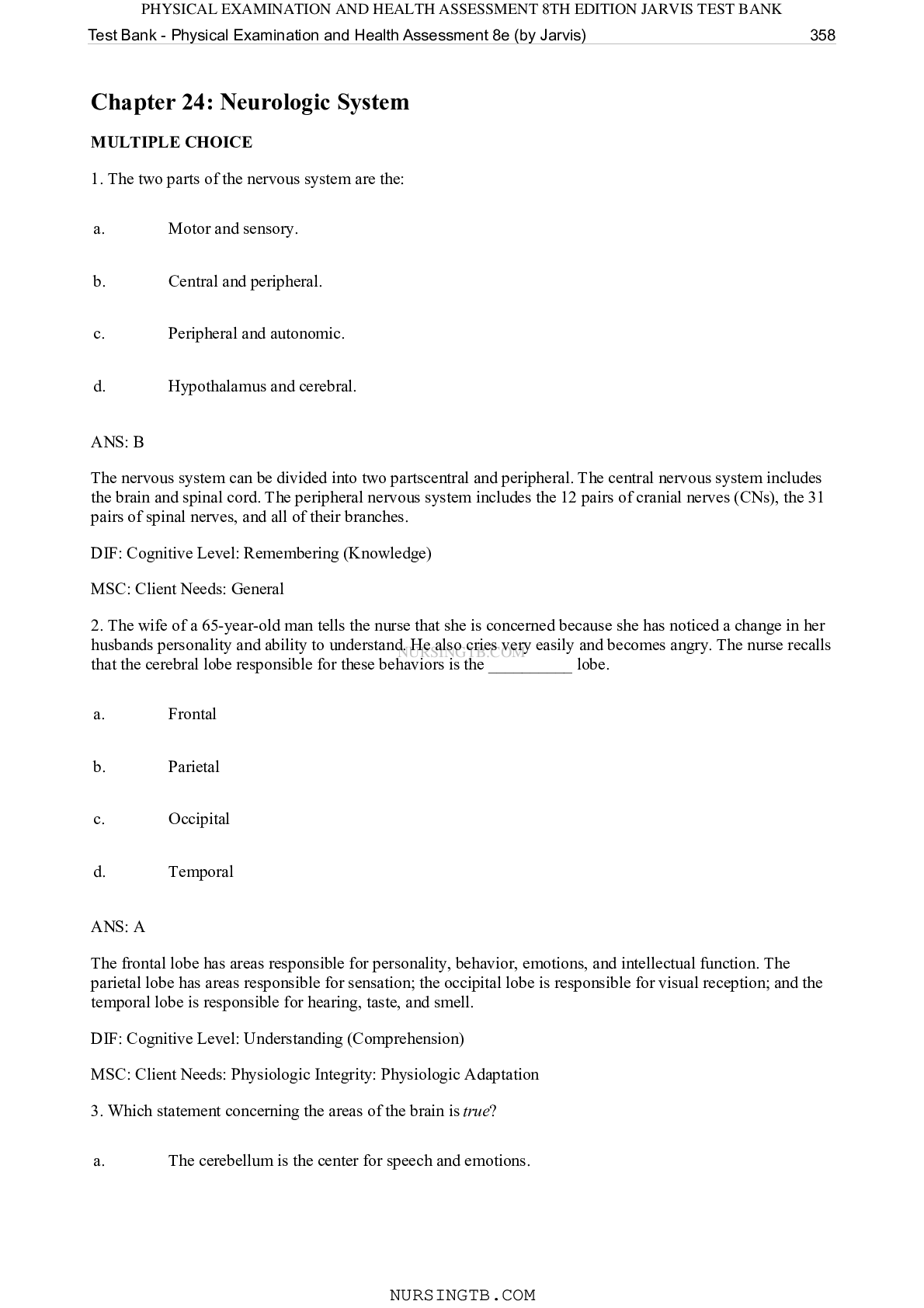*NURSING > QUESTIONS & ANSWERS > SOLVED!!! NR 509 COMPREHENSIVE REVIEW OF JARVIS 7TH EDITION CHAPTER 10 QUESTIONS (All)
SOLVED!!! NR 509 COMPREHENSIVE REVIEW OF JARVIS 7TH EDITION CHAPTER 10 QUESTIONS
Document Content and Description Below
SOLVED!!! NR 509 COMPREHENSIVE REVIEW OF JARVIS 7TH EDITION CHAPTER 10 QUESTIONS (Pain Assessment: The Fifth Vital Sign: Physical Examination & Health Assessment) ◇This material contains comprehensi... ve summary of information in the form of great test questions with descriptive answers helpful for exams study. Thorough Review of Jarvis 7th Edition Chapter 10 Questions. All the best Champions!!! ______ MULTIPLE CHOICE 1. When evaluating a patient’s pain, the nurse knows that an example of acute pain would be: a. Arthritic pain. b. Fibromyalgia. c. Kidney stones. d. Low back pain. ANS: C Acute pain is short-term and dissipates after an injury heals, such as with kidney stones. The other conditions are examples of chronic pain during which the pain continues for 6 months or longer and does not stop when the injury heals. DIF: Cognitive Level: Understanding (Comprehension) REF: p. 164 MSC: Client Needs: Physiologic Integrity: Basic Care and Comfort 2. Which statement indicates that the nurse understands the pain experienced by an older adult? a. “Older adults must learn to tolerate pain.” b. “Pain is a normal process of aging and is to be expected.” c. “Pain indicates a pathologic condition or an injury and is not a normal process of aging.” d. “Older individuals perceive pain to a lesser degree than do younger individuals.” ANS: C Pain indicates a pathologic condition or an injury and should never be considered something that an older adult should expect or tolerate. Pain is not a normal process of aging, and no evidence suggests that pain perception is reduced with aging. DIF: Cognitive Level: Applying (Application) REF: p. 165 MSC: Client Needs: Physiologic Integrity: Basic Care and Comfort 3. A 4-year-old boy is brought to the emergency department by his mother. She says he points to his stomach and says, “It hurts so bad.” Which pain assessment tool would be the best choice when assessing this child’s pain? a. Descriptor Scale b. Numeric rating scale c. Brief Pain Inventory d. Faces Pain Scale—Revised (FPS-R) ANS: D Rating scales can be introduced at the age of 4 or 5 years. The FPS-R is designed for use by children and asks the child to choose a face that shows “how much hurt (or pain) you have now.” Young children should not be asked to rate pain by using numbers. DIF: Cognitive Level: Applying (Application) REF: p. 170 MSC: Client Needs: Physiologic Integrity: Basic Care and Comfort 4. A patient states that the pain medication is “not working” and rates his postoperative pain at a 10 on a 1-to-10 scale. Which of these assessment findings indicates an acute pain response to poorly controlled pain? a. Confusion b. Hyperventilation c. Increased blood pressure and pulse d. Depression ANS: C Responses to poorly controlled acute pain include tachycardia, elevated blood pressure, and hypoventilation. Confusion and depression are associated with poorly controlled chronic pain (see Table 10-1). DIF: Cognitive Level: Analyzing (Analysis) REF: p. 172 MSC: Client Needs: Physiologic Integrity: Basic Care and Comfort 5. A 60-year-old woman has developed reflexive sympathetic dystrophy after arthroscopic repair of her shoulder. A key feature of this condition is that the: a. Affected extremity will eventually regain its function. b. Pain is felt at one site but originates from another location. c. Patient’s pain will be associated with nausea, pallor, and diaphoresis. d. Slightest touch, such as a sleeve brushing against her arm, causes severe and intense pain. ANS: D A key feature of reflexive sympathetic dystrophy is that a typically innocuous stimulus can create a severe, intensely painful response. The affected extremity becomes less functional over time. DIF: Cognitive Level: Understanding (Comprehension) REF: p. 178 MSC: Client Needs: Physiologic Integrity: Basic Care and Comfort 6. The nurse is assessing a patient’s pain. The nurse knows that the most reliable indicator of pain would be the: a. Patient’s vital signs. b. Physical examination. c. Results of a computerized axial tomographic scan. d. Subjective report. ANS: D The subjective report is the most reliable indicator of pain. Physical examination findings can lend support, but the clinician cannot exclusively base the diagnosis of pain on physical assessment findings. DIF: Cognitive Level: Understanding (Comprehension) REF: p. 166 MSC: Client Needs: Safe and Effective Care Environment: Management of Care 7. A patient has had arthritic pain in her hips for several years since a hip fracture. She is able to move around in her room and has not offered any complaints so far this morning. However, when asked, she states that her pain is “bad this morning” and rates it at an 8 on a 1-to-10 scale. What does the nurse suspect? The patient: Is addicted to her pain medications and cannot obtain pain relief. This study source was downloaded by 100000830034489 from CourseHero.com on 09-11-2021 17:16:29 GMT -05:00 https://www.coursehero.com/file/12406896/c10/ a. This study resource was shared via CourseHero.comb. Does not want to trouble the nursing staff with her complaints. c. Is not in pain but rates it high to receive pain medication. d. Has experienced chronic pain for years and has adapted to it. ANS: D Persons with chronic pain typically try to give little indication that they are in pain and, over time, adapt to the pain. As a result, they are at risk for underdetection. DIF: Cognitive Level: Analyzing (Analysis) REF: p. 172 MSC: Client Needs: Safe and Effective Care Environment: Management of Care 8. The nurse is reviewing the principles of pain. Which type of pain is due to an abnormal processing of the pain impulse through the peripheral or central nervous system? a. Visceral b. Referred c. Cutaneous d. Neuropathic ANS: D Neuropathic pain implies an abnormal processing of the pain message. The other types of pain are named according to their sources. DIF: Cognitive Level: Remembering (Knowledge) REF: p. 162 MSC: Client Needs: Safe and Effective Care Environment: Management of Care 9. When assessing the quality of a patient’s pain, the nurse should ask which question? a. “When did the pain start?” b. “Is the pain a stabbing pain?” c. “Is it a sharp pain or dull pain?” d. “What does your pain feel like?” ANS: D To assess the quality of a person’s pain, the patient is asked to describe the pain in his or her own words. DIF: Cognitive Level: Analyzing (Analysis) REF: p. 166 MSC: Client Needs: Safe and Effective Care Environment: Management of Care 10. When assessing a patient’s pain, the nurse knows that an example of visceral pain would be: a. Hip fracture. b. Cholecystitis. c. Second-degree burns. d. Pain after a leg amputation. ANS: B Visceral pain originates from the larger interior organs, such as the gallbladder, liver, or kidneys. DIF: Cognitive Level: Understanding (Comprehension) REF: p. 164 MSC: Client Needs: Safe and Effective Care Environment: Management of Care [Show More]
Last updated: 2 years ago
Preview 1 out of 6 pages

Buy this document to get the full access instantly
Instant Download Access after purchase
Buy NowInstant download
We Accept:

Reviews( 0 )
$15.00
Can't find what you want? Try our AI powered Search
Document information
Connected school, study & course
About the document
Uploaded On
Sep 13, 2021
Number of pages
6
Written in
Additional information
This document has been written for:
Uploaded
Sep 13, 2021
Downloads
0
Views
109





.png)
.png)
.png)
.png)

.png)




.png)

.png)



